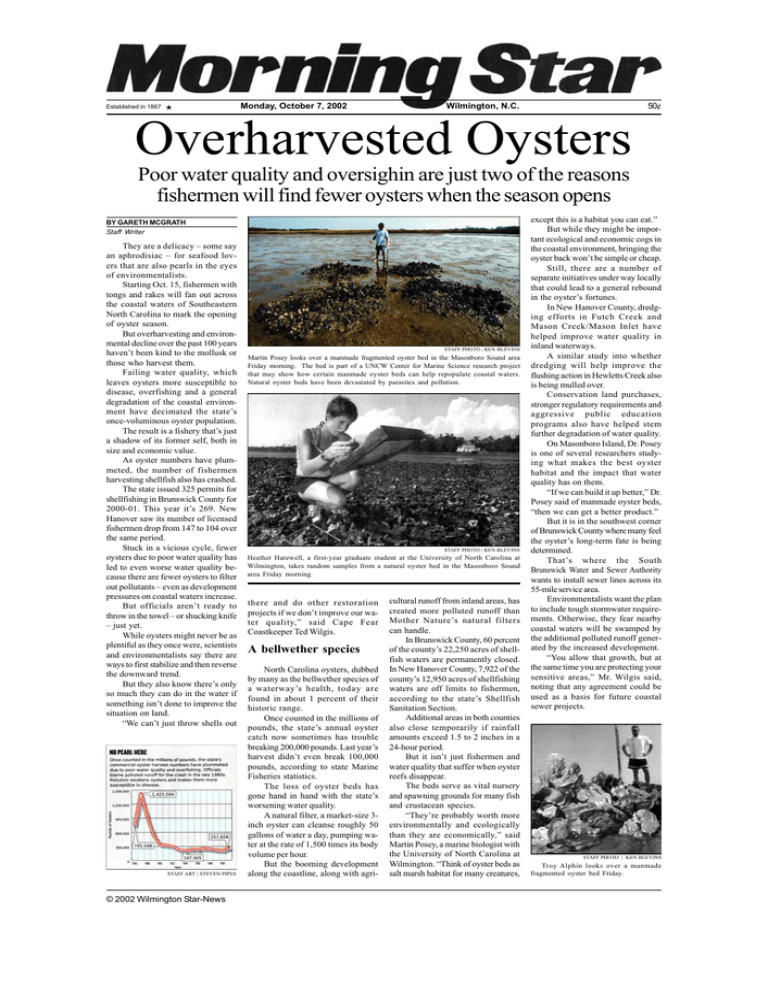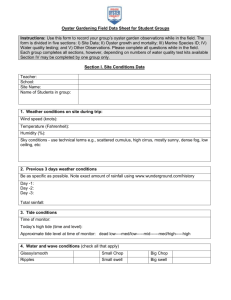Overharvested Oysters
advertisement

Monday, October 7, 2002 Established in 1867 Wilmington, N.C. Overharvested Oysters 50¢ Poor water quality and oversighin are just two of the reasons fishermen will find fewer oysters when the season opens BY GARETH MCGRATH Staff Writer They are a delicacy – some say an aphrodisiac – for seafood lovers that are also pearls in the eyes of environmentalists. Starting Oct. 15, fishermen with tongs and rakes will fan out across the coastal waters of Southeastern North Carolina to mark the opening of oyster season. But overharvesting and environmental decline over the past 100 years haven’t been kind to the mollusk or those who harvest them. Failing water quality, which leaves oysters more susceptible to disease, overfishing and a general degradation of the coastal environment have decimated the state’s once-voluminous oyster population. The result is a fishery that’s just a shadow of its former self, both in size and economic value. As oyster numbers have plummeted, the number of fishermen harvesting shellfish also has crashed. The state issued 325 permits for shellfishing in Brunswick County for 2000-01. This year it’s 269. New Hanover saw its number of licensed fishermen drop from 147 to 104 over the same period. Stuck in a vicious cycle, fewer oysters due to poor water quality has led to even worse water quality because there are fewer oysters to filter out pollutants – even as development pressures on coastal waters increase. But officials aren’t ready to throw in the towel – or shucking knife – just yet. While oysters might never be as plentiful as they once were, scientists and environmentalists say there are ways to first stabilize and then reverse the downward trend. But they also know there’s only so much they can do in the water if something isn’t done to improve the situation on land. “We can’t just throw shells out STAFF ART | STEVEN PIPES © 2002 Wilmington Star-News STAFF PHOTO | KEN BLEVINS Martin Posey looks over a manmade fragmented oyster bed in the Masonboro Sound area Friday morning. The bed is part of a UNCW Center for Marine Science research project that may show how certain manmade oyster beds can help repopulate coastal waters. Natural oyster beds have been devastated by parasites and pollution. STAFF PHOTO | KEN BLEVINS Heather Harewell, a first-year graduate student at the University of North Carolina at Wilmington, takes random samples from a natural oyster bed in the Masonboro Sound area Friday morning. there and do other restoration projects if we don’t improve our water quality,” said Cape Fear Coastkeeper Ted Wilgis. A bellwether species North Carolina oysters, dubbed by many as the bellwether species of a waterway’s health, today are found in about 1 percent of their historic range. Once counted in the millions of pounds, the state’s annual oyster catch now sometimes has trouble breaking 200,000 pounds. Last year’s harvest didn’t even break 100,000 pounds, according to state Marine Fisheries statistics. The loss of oyster beds has gone hand in hand with the state’s worsening water quality. A natural filter, a market-size 3inch oyster can cleanse roughly 50 gallons of water a day, pumping water at the rate of 1,500 times its body volume per hour. But the booming development along the coastline, along with agri- cultural runoff from inland areas, has created more polluted runoff than Mother Nature’s natural filters can handle. In Brunswick County, 60 percent of the county’s 22,250 acres of shellfish waters are permanently closed. In New Hanover County, 7,922 of the county’s 12,950 acres of shellfishing waters are off limits to fishermen, according to the state’s Shellfish Sanitation Section. Additional areas in both counties also close temporarily if rainfall amounts exceed 1.5 to 2 inches in a 24-hour period. But it isn’t just fishermen and water quality that suffer when oyster reefs disappear. The beds serve as vital nursery and spawning grounds for many fish and crustacean species. “They’re probably worth more environmentally and ecologically than they are economically,” said Martin Posey, a marine biologist with the University of North Carolina at Wilmington. “Think of oyster beds as salt marsh habitat for many creatures, except this is a habitat you can eat.” But while they might be important ecological and economic cogs in the coastal environment, bringing the oyster back won’t be simple or cheap. Still, there are a number of separate initiatives under way locally that could lead to a general rebound in the oyster’s fortunes. In New Hanover County, dredging efforts in Futch Creek and Mason Creek/Mason Inlet have helped improve water quality in inland waterways. A similar study into whether dredging will help improve the flushing action in Hewletts Creek also is being mulled over. Conservation land purchases, stronger regulatory requirements and aggressive public education programs also have helped stem further degradation of water quality. On Masonboro Island, Dr. Posey is one of several researchers studying what makes the best oyster habitat and the impact that water quality has on them. “If we can build it up better,” Dr. Posey said of manmade oyster beds, “then we can get a better product.” But it is in the southwest corner of Brunswick County where many feel the oyster’s long-term fate is being determined. That’s where the South Brunswick Water and Sewer Authority wants to install sewer lines across its 55-mile service area. Environmentalists want the plan to include tough stormwater requirements. Otherwise, they fear nearby coastal waters will be swamped by the additional polluted runoff generated by the increased development. “You allow that growth, but at the same time you are protecting your sensitive areas,” Mr. Wilgis said, noting that any agreement could be used as a basis for future coastal sewer projects. STAFF PHOTO | KEN BLEVINS Troy Alphin looks over a manmade fragmented oyster bed Friday.








